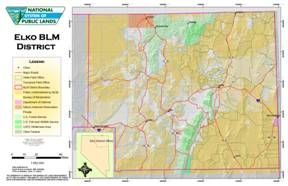 The Elko District Office consists of the Tuscarora and the Wells Field Offices. Between the two field offices, range staff administer livestock grazing on 245 allotments located in parts of Elko, Eureka, Lander, Humboldt and White Pine counties. A total of 190 permittees hold permits to graze cattle, horses and/or sheep on lands managed by the Elko District.
The Elko District Office consists of the Tuscarora and the Wells Field Offices. Between the two field offices, range staff administer livestock grazing on 245 allotments located in parts of Elko, Eureka, Lander, Humboldt and White Pine counties. A total of 190 permittees hold permits to graze cattle, horses and/or sheep on lands managed by the Elko District.
The range staff is responsible for issuing grazing permits to the permittees, billing for grazing use on public lands, assessing and mitigating the impacts of livestock grazing on land health, overseeing the installation and maintenance of range improvements and monitoring livestock use to insure compliance with grazing rules and regulations. The range program also provides support and input to other programs in the office such as mining, realty, fire suppression and rehabilitation, fuels treatments, and noxious weed control. The range staff currently consists of two Assistant Field Managers, seven Rangeland Management Specialists, two Range Technicians, one Rangeland Management Specialist student trainee, one Natural Resource Specialist student trainee, and one Resource Assistant.
The Elko District which includes the Wells and Tuscarora Field Offices use:
Standards and Guidelines for Nevada’s Northeastern Great Basin Area
Current Grazing forms and applications
Cooperative Monitoring Program
Monitoring is the orderly collection, analysis, and interpretation of resource data to evaluate progress toward meeting management objectives.
In 2004, the Public Lands Council (PLC) and Bureau of Land Management (BLM) entered into a national memorandum of understanding (MOU) to encourage and support cooperative rangeland monitoring between the BLM and local members of the livestock industry. This includes joint monitoring between the BLM and livestock grazing permittees, monitoring conducted by the livestock permittee, and the exchange of information.
The PLC and BLM believe that interpretations of data and conclusions about resource conditions should be based principally on facts and data collected on the ground, along with professional judgment and the historic knowledge and practical experience of the livestock permittee. The Cooperative Monitoring Program is intended to provide a framework for the facts and data to be collected, analyzed, and shared with the public, and used by the BLM to make land management decisions. The PLC and BLM believe that this program is important to help stabilize livestock grazing on lands administered by the BLM, and to achieve desired range conditions in the future.
While recognizing that the BLM has a responsibility to coordinate, consult, and communicate with many different entities concerning management of the public lands, the MOU addresses interaction between the BLM and Public Land Council who represents members of the livestock industry operating on public lands. The MOU in no way precludes or restricts the involvement of other public land users, interested public, public or private land agencies, organizations or individuals from being involved in joint cooperative monitoring.
If you would like to learn more about this program, please contact the Elko BLM Office.










